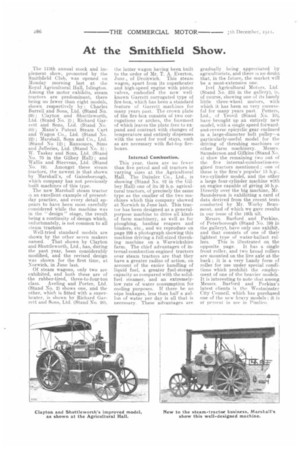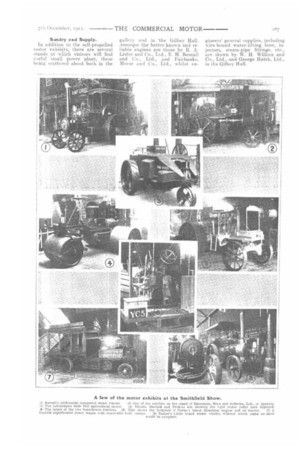At the Smithfield Show.
Page 4

Page 5

If you've noticed an error in this article please click here to report it so we can fix it.
The 113th annual stock and implement show, promoted by the Smithfield Club, was opened on Monday morning last at the Royal Agricultural Hall, Islington. Among the motor exhibits, steam tractors are predominant, there being no fewer than eight models, shown respectively by Charles Burrell and Sons, Ltd. (Stand No. 29); • Clayton and Shuttleworth, Ltd. (Stand No. 2) ; Richard Garrett and Sons, Ltd. (Stand No. ZO); Mann's Patent Steam Cart and Wagon Co,. Ltd. (Stand No. 22); Marshall, Sons and Co., Ltd. (Stand No 12'
) Ransomes, Sims and Jefferies, Ltd. (Stand No. 5) ; W. Tasker and Sons, Ltd. (Stand No. 70 in the Gilbey Hall); and 'Wallis and Steevens, Ltd. (Stand No. 19). Amongst these steam tractors, the newest is that shown by Marshall's, of Gainsborough, which company has not previously built machines of this type.
The new Marshall steam tractor is an excellent example of presentclay practice, and every detail appears to have been most carefully .considered while the machine was in the " design" stage, the result being a continuity of design which, unfortunately, is not common to all -team tractors.
Well-tried standard models are shown by the other seven makers named. That shown by Clayton and Shuttleworth, Ltd., has, during the past year, been considerably modified, and the revised design was shown for the first time, at Norwich, in June last.
Of steam wagons, only two are exhibited, and both these are of the rubber-tired, three-to-four-ton class. Aveling and Porter, Ltd. (Stand No. 2) shows one, and the other, which is fitted with a superheater, is shown by Richard Garrett and Sons, Ltd. (Stand No. 20), the latter wagon having been built to the order of Mr. T. A. Everton, Junr., of Droitwich. This steam wagon, apart from its superheater and high-speed engine with piston valves, einbodieg the now wellknown Garrett corrugated type of fire-box, which has been a standard feature of Garrett machines for many years past. The crown plate of the fire-box consists of two corrugations or arches, the foremost of which leaves the plate free to expand and contract with changes of temperature and entirely dispenses with the need for roof stays, such as are necessary with flat-top fireboxes.
Internal Combustion.
This year, there are no fewer than five petrol and oil tractors in varying sizes at the Agricultural Hall. The Daimler Co., Ltd., is showing (Stand No. 82 in the Ciibey Hall) one of its 36 h.p. agricultural tractors, of precisely the same type as the smaller of the two machines which this company showed at Norwich in June last. This tractor has been designed as a generalpurpose machine to drive all kinds of farm machinery, as well as for ploughing, hauling reapers and binders, etc., and we reproduce on page 299 a photograph showing this machine driving a full-sized threshing machine on a Warwickshire farm, The chief advantages of internal-combustion-engined tractors over steam tractors are that they have a greater radius of action, on account of the easier handling of liquid fuel, a greater fuel-storage capacity as compared with the solidfuel steamer, and an extremelylow rate of water consumption for cooling purposes. If there be no nipe leakages, less than half a gallon of water per day is all that is necessary. These advantages are
gradually being appreciated by agriculturists, and there is no doubt that, in the future, the market will be a most-extensive one.
lvel Agricultural Motors, Ltd. (Stand No. 235 in the gallery), is, of course, showing one of its handy little three-wheel motors, with which it has been so very successful for many years past. Petters, Ltd., of Yeovil (Stand No. 10), have brought up an entirely new model, with a single speed forwardand-reverse epieyclic gear enclosed in a large-diameter belt pulley—a particularly-useful model for the. driving of threshing mar limes or other farm machinery. Messrs. Saunderson and Gifkins (Stand No. 4) show the remaining two out of the five internal-combustion-enginecl tractors mentioned ; one of these is the firm's popular 15 h.p., two-cylinder model, and the other a large four-cylinder machine with an engine capable of giving 60 h.p. Directly over the big machine, Mr. Saunderson is exhibiting a card of data derived from the recent tests conducted by Mr. Worbv Beaumont, and of which we gave results in our issue of the 16th ult.
Messrs. Barford , and Perkins, of Peterborough (Stand No. 398 in the gallery), have only one exhibit, and that consists of one of their lightest type of water-ballast rol lers. This is illustrated on the opposite page. It has a single front roller, and two broad rollers are mounted on the live axle at the back ; it is a very handy form of roller for use under special conditions which prohibit the employment of one of the heavier models. It is interesting to note that among Messrs. Barford and Perkins's latest clients is the Westminster City Council, which has purchased one of the new heavy models ; it is at present in use in Pimlico. Sundry and Supply.
In addition to the self-propelled motor exhibits, there are several stands at wriich visitors will find useful small power plant, these being scattered about both in the gallery arid in the Gilbey
Amongst the better known and reliable engines are those by R. A. Lister and Co., Ltd., E. H. Bentall and Co., Ltd., and Fairbanks, Morse and CO., Ltd., whilst en
gineers general supplies, including wire-bound water-lifting hose, injectors, steam-pipe fittings, etc., are shown by W. H. Willcox and Co., Ltd., and George Hatch, Ltd., in the Gilbey Hall.




















